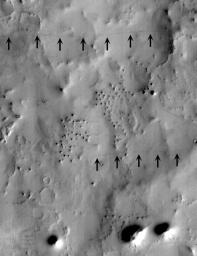
|
SUV Tracks On Mars? The “Devil” is in the Details
- Click the image above for a larger view
- Full-Res JPEG (560 x 730) (52.8 kB)
- Full-Res TIFF (560 x 730) (367.8 kB)
Caption:
Sport Utility Vehicles (SUVs) on Mars? Imagine the MOC imaging team's surprise on the morning of April 27, 1998, as the latest images came in from the "Red Planet."
A picture taken by the camera on Mars Global Surveyor just one day earlier showed several thin, dark lines that--at first glance--looked like pathways blazed by off-road sport utility vehicles. Who's been driving around on Mars?
The MOC image in question (#26403), seen here at full resolution of 13.8 meters (45 feet) per pixel, was obtained around 10:22 a.m. PDT on April 26, 1998, during Mars Global Surveyor's 264th orbit. North is approximately up, illumination is from the lower right. Located in eastern Arabia Terra near 16.5° N latitude, 311.4° W longitude, the image showed a number of natural features--small craters formed by meteor impact, several buttes and mesas left by erosion of the surrounding terrain, small dunes and drifts, and a mantle of dust that varies in thickness from place to place. But the new picture also showed two dark lines--each varying in width up to about 15 meters (49 feet)--that extended several kilometers/miles across the image.
Lines like these have been seen before on Mars. They are most likely the result of dust devils--columnar vortices of wind that move across the landscape, pick up dust, and look somewhat like miniature tornadoes. Dust devils are a common occurrence in dry and desert landscapes on Earth as well as Mars. They form when the ground heats up during the day, warming the air immediately above the surface. As pockets of warm air rise and interfere with one another, they create horizontal pressure variations that, combined with other meteorological winds, cause the upward moving air to spin (the direction of the spin is controlled by the same Coriolis forces that cause terrestrial hurricanes to spin in specific directions). As the spinning column of air moves across the surface, it occasionally encounters dust on the surface, which it can suck upward. This dust rises into the spinning air, giving the appearance of a tornado-like column that moves across the landscape. As the column of air moves, its ability to pick up dust varies--sometimes they hold a lot of dust and are nearly opaque; sometimes you cannot even see them. Dust-devils rarely last long, since their very motion changes the conditions that allowed them to form in the first place.
Mars Pathfinder detected the passage of several dust devils during its 83 days of operation on Mars in 1997. Mariner 9 and the Viking landers and orbiters of the 1970s also found evidence that dust devils occur on Mars; indeed, some Viking Orbiter images actually show dust devil clouds. MOC image 26403 is the latest entry in the body of evidence for the work of wind in the modern martian environment. The MOC Science Team is continuing to study these and other streaks caused by wind interacting with the martian surface.
Background Info:
Malin Space Science Systems and the California Institute of Technology built the MOC using spare hardware from the Mars Observer mission. MSSS operates the camera from its facilities in San Diego, CA. The Jet Propulsion Laboratory's Mars Surveyor Operations Project operates the Mars Global Surveyor spacecraft with its industrial partner, Lockheed Martin Astronautics, from facilities in Pasadena, CA and Denver, CO.
Cataloging Keywords:
| Name | Value | Additional Values |
|---|---|---|
| Target | Mars | |
| System | ||
| Target Type | Planet | |
| Mission | Mars Global Surveyor (MGS) | Mariner, Mars Pathfinder (MPF), Viking |
| Instrument Host | Mars Global Surveyor | |
| Host Type | Orbiter | Flyby Spacecraft |
| Instrument | Mars Orbiter Camera (MOC) | |
| Detector | ||
| Extra Keywords | Crater, Dune, Dust, Grayscale, Impact, Rotation | |
| Acquisition Date | ||
| Release Date | 1998-07-31 | |
| Date in Caption | 1998-04-26 | 1998-04-27 |
| Image Credit | NASA/JPL/Malin Space Science Systems | |
| Source | photojournal.jpl.nasa.gov/catalog/PIA01463 | |
| Identifier | PIA01463 | |
